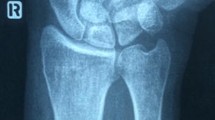Abstract
Flexor tendon rupture is an unusual complication following collagenase injection to relieve contractures. These patients require a close follow-up and in the event of tendon rupture, a decision has to be made whether to repair the tendon or manage the complication conservatively. The authors report the utility of MRI in the prognostication and management of a patient with Dupuytren’s contracture, who underwent collagenase injection and subsequently developed flexor digitorum profundus tendon rupture.




Similar content being viewed by others
References
Wilburn J, McKenna SP, Perry-Hinsley D, Bayat A. The impact of Dupuytren disease on patient activity and quality of life. J Hand Surg [Am]. 2013;38(6):1209–14.
Gilpin D, Coleman S, Hall S, Houston A, Karrasch J, Jones N. Injectable collagenase Clostridium histolyticum: a new nonsurgical treatment for Dupuytren’s disease. J Hand Surg [Am]. 2010;35(12):2027–2038.e1.
Coert JH, Nerin JP, Meek MF. Results of partial fasciectomy for Dupuytren disease in 261 consecutive patients. Ann Plast Surg. 2006;57(1):13–7.
Zhang AY, Curtin CM, Hentz VR. Flexor tendon rupture after collagenase injection for Dupuytren contracture: case report. J Hand Surg [Am]. 2011;36(8):1323–5.
Povlsen B, Singh S. Acute double flexor tendon ruptures following injection of collagenase clostridium histolyticum (Xiapex) for Dupuytren’s contracture. BMJ Case Rep. 2014. 10.1136/bcr-2013-203338.
Hodgson RJ, O’Connor PJ, Grainger AJ. Tendon and ligament imaging. Br J Radiol. 2012;85(1016):1157–72.
Picardo NE, Khan WS. Advances in the understanding of the aetiology of Dupuytren’s disease. Surgeon. 2012;10(3):151–8.
Sweet S, Blackmore S. Surgical and therapy update on the management of Dupuytren’s disease. J Hand Ther. 2014;27(2):77–83. quiz 4.
Syed F, Thomas AN, Singh S, Kolluru V, Emeigh Hart SG, Bayat A. In vitro study of novel collagenase (XIAFLEX®) on Dupuytren’s disease fibroblasts displays unique drug related properties. PLoS One. 2012;7(2):e31430.
Coleman S, Gilpin D, Kaplan FT, Houston A, Kaufman GJ, Cohen BM, et al. Efficacy and safety of concurrent collagenase clostridium histolyticum injections for multiple Dupuytren contractures. J Hand Surg [Am]. 2014;39(1):57–64.
Badalamente MA, Hurst LC, Benhaim P, Cohen BM. Efficacy and safety of collagenase clostridium histolyticum in the treatment of proximal interphalangeal joints in Dupuytren contracture: combined analysis of 4 phase 3 clinical trials. J Hand Surg [Am]. 2015;40(5):975–83.
Watt AJ, Curtin CM, Hentz VR. Collagenase injection as nonsurgical treatment of Dupuytren’s disease: 8-year follow-up. J Hand Surg [Am]. 2010;35(4):534–9, 539.e1.
Crivello KM, Potter HG, Moon ES, Rancy SK, Wolfe SW. Does collagenase injection disrupt or digest the Dupuytren’s cord: a magnetic resonance imaging study. J Hand Surg Eur Vol. 2016;41(6):614–20.
Hayton MJ, Bayat A, Chapman DS, Gerber RA, Szczypa PP. Isolated and spontaneous correction of proximal interphalangeal joint contractures in Dupuytren’s disease: an exploratory analysis of the efficacy and safety of collagenase Clostridium histolyticum. Clin Drug Investig. 2013;33(12):905–12.
Peimer CA, Wilbrand S, Gerber RA, Chapman D, Szczypa PP. Safety and tolerability of collagenase Clostridium histolyticum and fasciectomy for Dupuytren’s contracture. J Hand Surg Eur Vol. 2015;40(2):141–9.
Lee DH, Han SB, Park JW, Lee SH, Kim KW, Jeong WK. Sonographically guided tendon sheath injections are more accurate than blind injections: implications for trigger finger treatment. J Ultrasound Med. 2011;30(2):197–203.
Bianchi S, Martinoli C, de Gautard R, Gaignot C. Ultrasound of the digital flexor system: normal and pathological findings(). J Ultrasound. 2007;10(2):85–92.
Author information
Authors and Affiliations
Ethics declarations
Disclosures
Dr Chhabra has received research grants from GE-AUR (GERRAF), Siemens Medical Solutions, Gatewood Fellowship Award and Integra Life Sciences. He also serves as a research consultant with Siemens CAD group. These are unrelated to the current work.
Conflicts of interest
All authors report that they have no conflicts of interest.
Rights and permissions
About this article
Cite this article
Khurana, S., Wadhwa, V., Chhabra, A. et al. MRI in flexor tendon rupture after collagenase injection. Skeletal Radiol 46, 237–240 (2017). https://doi.org/10.1007/s00256-016-2524-2
Received:
Revised:
Accepted:
Published:
Issue Date:
DOI: https://doi.org/10.1007/s00256-016-2524-2




